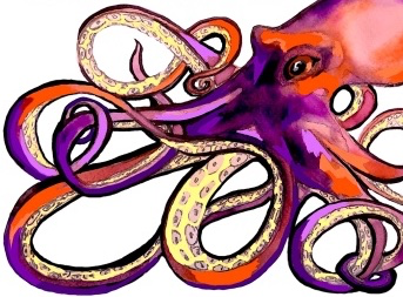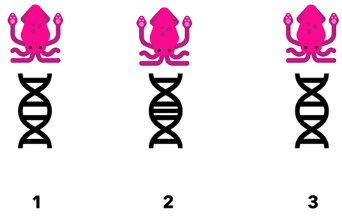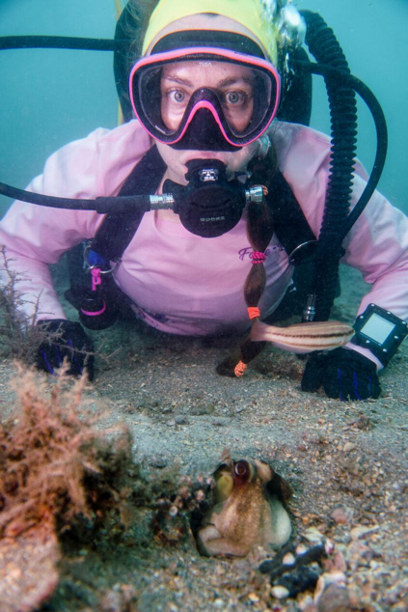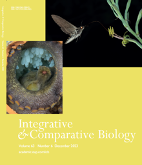By: Colleen Hecker, Master’s Student at Florida Atlantic University, Boca Raton, FL, USA

Lions, tigers, and bears-oh my! Aside from being lumped together in this iconic film, the three creatures Dorothy, the Tinman, and the Scarecrow were afraid of meeting on their way to Oz, lions, tigers, and bears also share a few other similarities. Despite their shared traits, these three animals simply do not look alike. Nonetheless, different species sometimes look very similar, and the lines between species can become blurred. In their new paper, “Atlantic Oceanic Squids in the ‘Grey Speciation Zone,’” Fernánedz-Álvarez et al. took a plunge into a place like the odd world of Oz known as the “grey speciation zone.” Here, the boundaries between species aren’t always clear, and depending on the approach used to identify a species, results may vary.
If you’re smitten with squids, curious about what constitutes a species, or just like a good old fashioned science mystery, there is something in this paper for you! Personally, “Atlantic Oceanic Squids in the ‘Grey Speciation Zone,’ focused on a topic near and dear to my heart, cephalopod species identification. Cephalopods, like octopuses and squids, are marveled at for their expert camouflage and ability to squeeze their soft bodies through impossibly tight spaces. Beyond these endearing attributes, many don’t realize how difficult it is to accurately identify cephalopods at the species-level. For my master’s thesis research at Florida Atlantic University, I am attempting to identify hard-to-discern octopus species, and my peers’ jaws often hit the floor when I explain to them that I can’t definitively state which species I am focusing on until I analyze their unique DNA.
So, why is it so difficult to identify cephalopod species?
One read of “Atlantic Oceanic Squids in the ‘Grey Speciation Zone’” makes it clear with a brief history lesson. Many squid species were long thought to be cosmopolitan, meaning that they were found worldwide. Afterall, squids are marine animals, and the world’s oceans are interconnected. For a long time, we assumed that the ocean was devoid of barriers that would prevent populations from breeding. Now that squid DNA can be studied with relative ease, it turns out that many species are harboring hidden cryptic biodiversity. This means that when squid DNA is unraveled and analyzed, squids that look like they belong to the same species may actually represent a complex of numerous, different species. We call these hard to discern species, cryptic species. I like to simplify this brief history lesson to cosmopolitan, cryptic, and complex- oh my!
Wait, what is a cryptic species?
Very simply put, cryptic species may appear virtually identical to another species, but are genetically different. In the image below, we can consider Squid # 2 to be a cryptic species, since its DNA differs from Squids 1 & 3. I often use this image, substituting the squids with octopuses when explaining my own research about cryptic species to broad audiences.

Fernánedz-Álvarez et al. set out to investigate this cryptic biodiversity among oceanic squids with an added twist. Remember when I said that the ocean was long thought to be lacking in barriers to interbreeding? Well, it turns out that major currents in the world’s oceans may represent significant barriers after all. These authors tested whether these currents had any influence on the cryptic biodiversity of squids.
After sampling squid species found on either side of a major current, they then uncovered the secret cryptic biodiversity hidden in their genes. Overall, these currents did not seem to have an impact on cryptic diversity among the 16 species they examined, save for a few examples like Teuthowenia spp. and Helicocranchia sp. Beyond that, their findings were far from simple, and led them into the biologists’ Oz- the ‘grey speciation zone.’

In the ‘grey speciation zone’, nothing is straightforward. Four of the squid species sampled turned out to be harboring quite a bit of cryptic biodiversity in their genes. These species were:
🦑 Comb finned squid (Chtenopteryx sicula)
🦑 Canaries comb-finned squid (Chtenopteryx canariensis)
🦑 Sharpear enope squid (Ancistrocheirus lesueurii)
🦑 Armed cranch squid (Galiteuthis armarta)
For these four taxa, this means that they may not represent a single species at all. Instead, they might constitute cryptic species complexes, harboring several unique species (oh my!). To make things even more complicated, it is difficult to state just how many cryptic species were uncovered for each of these taxa. Among the four genes and molecular markers used in this study, results were variable. Where one gene analyzed in a (seemingly) single squid species might uncover up to four new cryptic species, a different gene may only reveal a single species, as was the case for C. sicula in this study.
Similarly, the other three taxaall harbored varying levels of cryptic biodiversity depending on the gene or molecular marker in question. Since these results are so variable, these four squid species are stuck in the taxonomic limbo of the ‘grey speciation zone’ for the time being. While we may one day come to recognize these four taxa as cryptic species complexes, we can’t quite begin to define those complexes just yet.
Now that you too have taken a glimpse into the ‘grey speciation zone,’ I’m afraid you cannot click your ruby slippers together and return to Kansas. Future studies will be needed to accurately catalogue the biodiversity of squids and other organisms in this taxonomic zone of uncertainty. As we endure the current mass extinction event, it is imperative that we catalogue species correctly to better address their conservation. This is the reason I personally decided to study cryptic octopus species for my master’s thesis. “Atlantic Oceanic Squids in the ‘Grey Speciation Zone’” was an excellent reminder for me of why I chose this field in the first place.
Give it a read today and get tangled in the DNA of cryptic squid species.
“Atlantic Oceanic Squids in the ‘Grey Speciation Zone,
https://doi.org/10.1093/icb/icad116

Connect with Fernando via X @cefafalopodo (post doc at @ICMCSIC)
& https://scholar.google.es/citations?user=zGr2mtAAAAAJ&hl=es
Connect with Colleen Hecker
Email: checker2018@fau.edu
Lab Website: https://biology.fau.edu/marine-lab/people/colleen-hecker-sea-scholars.php



